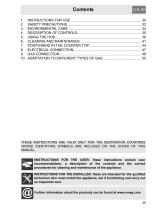
1. INSTRUCTIONS FOR USE ................................................................................................... 73
2. INSTRUCTIONS FOR DISPOSAL – OUR ENVIRONMENTAL CARE ................................. 75
3. INSTALLING THE APPLIANCE ............................................................................................ 76
3.1 Electrical connection .................................................................................................................................... 77
3.2 Room ventilation ........................................................................................................................................... 77
3.3 Extraction of the products of combustion ...................................................................................................... 77
3.4 Connection to gas ......................................................................................................................................... 78
4. ADAPTATION TO DIFFERENT TYPES OF GAS ................................................................. 80
4.1 Replacement of nozzles on the cooking hob ................................................................................................ 80
4.2 Burner and nozzle characteristics table (60/70 cm. model); ......................................................................... 81
4.3 Burner and nozzle characteristics table (90 cm. model); .............................................................................. 82
4.4 Arrangement of the burners on the cooking hob (Mod. 60 cm.) .................................................................... 83
4.5 Arrangement of the burners on the cooking hob (Mod. 70 cm.) .................................................................... 83
4.6 Arrangement of the burners on the cooking hob (Mod. 90 cm.) .................................................................... 83
4.7 Oven burner adjustment (only for models with a gas oven) .......................................................................... 83
5. FINAL OPERATIONS ............................................................................................................84
5.1 Regulation of the hob burners minimum for natural gas ............................................................................... 84
5.2 Regulation of the hob burners minimum for liquid gas .................................................................................. 84
5.3 Positioning and levelling the appliance (depending on the model) ............................................................... 84
5.4 Adjustment of the oven burner minimum ...................................................................................................... 84
6. CONTROL PANEL ................................................................................................................ 85
7. USING THE COOKING HOB ................................................................................................ 87
7.1 Lighting the hob burners ............................................................................................................................... 87
7.2 Practical hints for using the hob burners ....................................................................................................... 87
7.3 60 cm. cookers pan diameters ...................................................................................................................... 88
7.4 70 cm. cookers pan diameters ...................................................................................................................... 88
7.5 90 cm. cookers pan diameters ...................................................................................................................... 88
8. USING THE OVEN ................................................................................................................ 89
8.1 Warnings and general advice ........................................................................................................................ 89
8.2 Cooling fan .................................................................................................................................................... 89
8.3 Using the gas oven ....................................................................................................................................... 89
8.4 Using the electric grill .................................................................................................................................... 90
8.5 Storage compartment (only on some models) .............................................................................................. 90
9. AVAILABLE ACCESSORIES ................................................................................................ 91
10. CLEANING AND MAINTENANCE ....................................................................................... 92
10.1 Ordinary daily cleaning ................................................................................................................................ 92
10.2 Cleaning the parts of the cooking hob ......................................................................................................... 92
10.3 Cleaning the oven ....................................................................................................................................... 93
10.4 Cleaning the door glazing ........................................................................................................................... 93
11. EXTRAORDINARY MAINTENANCE ................................................................................... 94
11.1 Lubrication of gas oven taps and thermostat .............................................................................................. 94
11.2 Oven ventilation failure ................................................................................................................................ 94
11.3 Changing the light bulb ............................................................................................................................... 94
11.4 Removing the doors .................................................................................................................................... 94
11.5 Removing the door seal .............................................................................................................................. 94
Contents
INSTRUCTIONS FOR THE USER: these contain user advice, description of the commands and the
correct procedures for cleaning and maintenance of the appliance.
INSTRUCTIONS FOR THE INSTALLER: these are intended for the qualified technician who must
carry out an adequate inspection of the gas system, install the appliance, set it functioning and carry out
an inspection test.
72




















